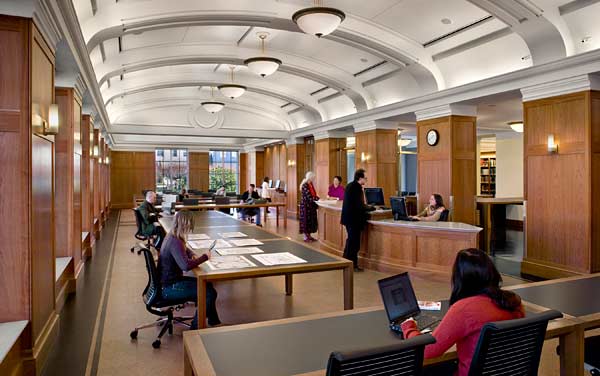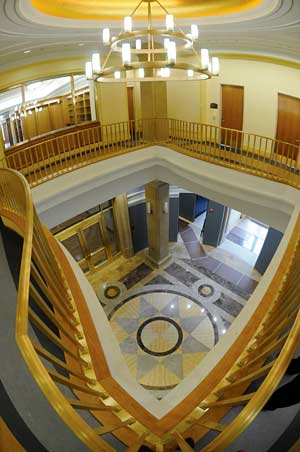 Architectural and design improvements to the Bancroft Library include the light-flooded Heller Reading Room. The Bancroft — whose archival collections occupy more than 55,000 linear feet of shelving — houses the University Archives, the Mark Twain Papers and Project, rare books and manuscripts, the Regional Oral History Office, paintings, millions of photographs, the Center for Tebtunis Papyri, four hand-powered printing presses, and wide-ranging literary collections representing the best of the Beat Generation writers as well as such authors as Joan Didion, Maxine Hong Kingston, Irving Stone, and Eldridge Cleaver. (David Wakely photo)
Architectural and design improvements to the Bancroft Library include the light-flooded Heller Reading Room. The Bancroft — whose archival collections occupy more than 55,000 linear feet of shelving — houses the University Archives, the Mark Twain Papers and Project, rare books and manuscripts, the Regional Oral History Office, paintings, millions of photographs, the Center for Tebtunis Papyri, four hand-powered printing presses, and wide-ranging literary collections representing the best of the Beat Generation writers as well as such authors as Joan Didion, Maxine Hong Kingston, Irving Stone, and Eldridge Cleaver. (David Wakely photo)Retrofitted and revamped, Bancroft reopens to regular hours
| 21 January 2009
BERKELEY — The Bancroft Library is back - and it's better than ever.
One of the University of California, Berkeley's premier special collections libraries, it reopened this week with regular hours following a three-year, $64 million seismic retrofit and upgrade financed in equal amounts by the state and more than 700 private donors.
"The renovations vastly improve our capability to serve the public," said Charles Faulhaber, the library's James D. Hart Director, noting that the project was completed on time and within budget.
Over the winter break, Bancroft was open with limited hours. With the start of the spring semester on Tuesday (Jan. 20), it resumed operation from 10 a.m. to 5 p.m. on weekdays.
Visitors now encounter a warm and welcoming public entry into a Beaux Arts-style rotunda with marble and onyx floors that contain cast bronze medallions representing key collections. Soft lighting flows through a gold-leaf dome and a grand staircase ascends to the second floor. These new features give the library an elegance that befits its priceless holdings.
The library is home to the world's finest collection of primary sources on the history of California and the American West. It also contains some of the most heavily used special collections materials in the country and draws readers from around the world.
 The two-story rotunda greets visitors to the significantly renovated space. (Peg Skorpinski photo)
The two-story rotunda greets visitors to the significantly renovated space. (Peg Skorpinski photo)It houses the University Archives, the Mark Twain Papers and Project, rare books and manuscripts, the Regional Oral History Office, paintings, millions of photographs, the Center for Tebtunis Papyri, original sketches of the atomic bomb, four hand-powered printing presses, and wide-ranging literary collections representing the best of the Beat Generation writers as well as authors including Joan Didion, Maxine Hong Kingston, Frank Norris, Bret Harte, Ambrose Bierce, Yoshiko Uchida, Eldridge Cleaver and others. Its archival collections occupy more than 55,000 linear feet, more than 10 miles in linear space.
Bancroft staff and some of the library's collections were temporarily housed in five locations on or near campus while the annex was gutted and revamped.
New physical features include basement-to-attic shear walls that seismically strengthened the structure. Three mezzanine levels were eliminated because they couldn't be retrofitted, converting the formerly nine-level Bancroft into a six-level building (including the basement) with about 75,000 square feet of surface space assigned for library purposes. Storage space was increased by about 25 percent through the use of compact shelving. A public passageway between Bancroft and the campus's adjacent Doe Library that was removed in 1972 has been restored.
The library's valuable collections also benefit from improved fire suppression systems, four different climate control zones with constant temperature and humidity controls to help preserve materials, a cold storage vault to protect film and prints, and the reinforcement of the first level's concrete floor to better bear the weight of items stored on 12-foot-high compact shelving.
There now are approximately 250 closed-circuit cameras and motion detectors spread throughout the building.
Drawing kudos is Bancroft's new Rotunda Gallery and its current exhibit, "Mark Twain at Play." University Archives and the UC Berkeley Museum of Vertebrate Zoology teamed up to produce the "Century of Innovative Research and Teaching" exhibit in the new Rowell exhibition cases (named for Joseph Rowell, the first University Librarian) on the east side of the corridor between Doe and Bancroft libraries.
The corridor to Doe Library also is displaying some of the photos from Bancroft's San Francisco Examiner photo collection, and the display extends to Doe's Bernice Layne Brown Gallery, which has a major Examiner photo exhibit.
Library patrons will appreciate The Bancroft Library's new wireless Internet access, state-of-the-art heating, ventilation and air conditioning systems, cork flooring for better acoustics in the light and spacious Edward Hellman Heller Reading Room overlooking Memorial Glade, and the new Class of 1958 Reading Room in the Mark Twain Papers suite. Bancroft also now has four meeting rooms, instead of the previous three.
Each year, Bancroft serves more than 12,000 inquisitive library users and records nearly 300,000 visits to its various Web pages, while answering close to 45,000 reference questions and hosting almost 200 course-related sessions for 19 different campus departments.
Its primary users come from College of Letters & Science departments such as history and English and from students of foreign languages such as Spanish, Latin, ancient Greek and Middle Persian/Pahlavi. But Faulhaber said he is seeing increased interest from scholars in other academic fields, including engineering and the sciences.
On that note, the first item charged out over Bancroft's new circulation desk was a microfilm containing correspondence, manuscripts and notes relating to the teaching and research of the late Robert Spencer Stone, a UC Berkeley professor of radiology and leader in the development of radiation therapy.
The renovation represents the library's latest incarnation since its inception by bookseller and publisher Hubert Howe Bancroft in 1860 and its acquisition by the campus in 1906. The Doe Library Annex, Bancroft's home since its construction in 1949, was in serious need of reconstruction and reconfiguration.
State funding for the seismic portion of the project came from Proposition 47, which California voters approved in 2002 to pay for seismic improvements to enhance public safety, and from the UC Office of the President.
Donations came from numerous private sources, including but not limited to the Wayne and Gladys Valley Foundation, the National Endowment for the Humanities, the Koret Foundation, the Hewlett Foundation, the Haas family funds and numerous private donors, including one anonymous $5 million donor.
Collaborating on Bancroft's new design were the architecture firms of Ratcliff (of Emeryville, Calif.) and Noll & Tam Architects (of Berkeley). McCarthy Building Companies was the construction manager and general contractor.
Design and construction were supervised by the campus's Capital Projects staff. The project took nine years from its initial planning - set in motion by Acting University Librarian Penny Abell in 1999 - to the finish of construction in summer 2008.
